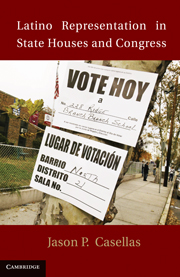25 results
Governing Texas
-
- Journal:
- PS: Political Science & Politics / Volume 55 / Issue 3 / July 2022
- Published online by Cambridge University Press:
- 30 March 2022, pp. 627-629
- Print publication:
- July 2022
-
- Article
- Export citation
Race, Partisanship, and Attitudes Toward Public Policy Commonality and Legislative Districts
-
- Journal:
- Journal of Race, Ethnicity and Politics / Volume 4 / Issue 1 / March 2019
- Published online by Cambridge University Press:
- 25 September 2018, pp. 32-59
-
- Article
- Export citation
Twists of Fate: Multiracial Coalitions and Minority Representation in the US House of Representatives. By Vanessa C. Tyson. New York: Oxford University Press, 2016. 208 pp., $35.00 (Cloth).
-
- Journal:
- Journal of Race, Ethnicity and Politics / Volume 3 / Issue 2 / September 2018
- Published online by Cambridge University Press:
- 08 June 2018, pp. 457-459
-
- Article
- Export citation
5 - Voices from Within
-
- Book:
- Latino Representation in State Houses and Congress
- Published online:
- 10 January 2011
- Print publication:
- 20 December 2010, pp 106-124
-
- Chapter
- Export citation

Latino Representation in State Houses and Congress
-
- Published online:
- 10 January 2011
- Print publication:
- 20 December 2010
Appendix C
-
- Book:
- Latino Representation in State Houses and Congress
- Published online:
- 10 January 2011
- Print publication:
- 20 December 2010, pp 157-158
-
- Chapter
- Export citation
6 - Roll Call Voting Behavior of Latino Legislators
-
- Book:
- Latino Representation in State Houses and Congress
- Published online:
- 10 January 2011
- Print publication:
- 20 December 2010, pp 125-137
-
- Chapter
- Export citation
1 - Latinos in Legislatures
-
- Book:
- Latino Representation in State Houses and Congress
- Published online:
- 10 January 2011
- Print publication:
- 20 December 2010, pp 19-32
-
- Chapter
- Export citation
Contents
-
- Book:
- Latino Representation in State Houses and Congress
- Published online:
- 10 January 2011
- Print publication:
- 20 December 2010, pp vii-ix
-
- Chapter
- Export citation
Introduction
-
- Book:
- Latino Representation in State Houses and Congress
- Published online:
- 10 January 2011
- Print publication:
- 20 December 2010, pp 1-18
-
- Chapter
- Export citation
Acknowledgments
-
- Book:
- Latino Representation in State Houses and Congress
- Published online:
- 10 January 2011
- Print publication:
- 20 December 2010, pp xv-xviii
-
- Chapter
- Export citation
3 - District Composition and the Election of Latino Candidates
-
- Book:
- Latino Representation in State Houses and Congress
- Published online:
- 10 January 2011
- Print publication:
- 20 December 2010, pp 51-75
-
- Chapter
- Export citation
4 - Electing Latinos in Non-Latino Majority Districts
-
- Book:
- Latino Representation in State Houses and Congress
- Published online:
- 10 January 2011
- Print publication:
- 20 December 2010, pp 76-105
-
- Chapter
- Export citation
2 - The Effects of Population, Turnover, and Term Limits on Latino Representation
-
- Book:
- Latino Representation in State Houses and Congress
- Published online:
- 10 January 2011
- Print publication:
- 20 December 2010, pp 33-50
-
- Chapter
- Export citation
List of Tables
-
- Book:
- Latino Representation in State Houses and Congress
- Published online:
- 10 January 2011
- Print publication:
- 20 December 2010, pp x-xii
-
- Chapter
- Export citation
Appendix E
-
- Book:
- Latino Representation in State Houses and Congress
- Published online:
- 10 January 2011
- Print publication:
- 20 December 2010, pp 161-162
-
- Chapter
- Export citation
List of Figures
-
- Book:
- Latino Representation in State Houses and Congress
- Published online:
- 10 January 2011
- Print publication:
- 20 December 2010, pp xiii-xiv
-
- Chapter
- Export citation
References
-
- Book:
- Latino Representation in State Houses and Congress
- Published online:
- 10 January 2011
- Print publication:
- 20 December 2010, pp 163-174
-
- Chapter
- Export citation
Frontmatter
-
- Book:
- Latino Representation in State Houses and Congress
- Published online:
- 10 January 2011
- Print publication:
- 20 December 2010, pp i-vi
-
- Chapter
- Export citation
Index
-
- Book:
- Latino Representation in State Houses and Congress
- Published online:
- 10 January 2011
- Print publication:
- 20 December 2010, pp 175-189
-
- Chapter
- Export citation



